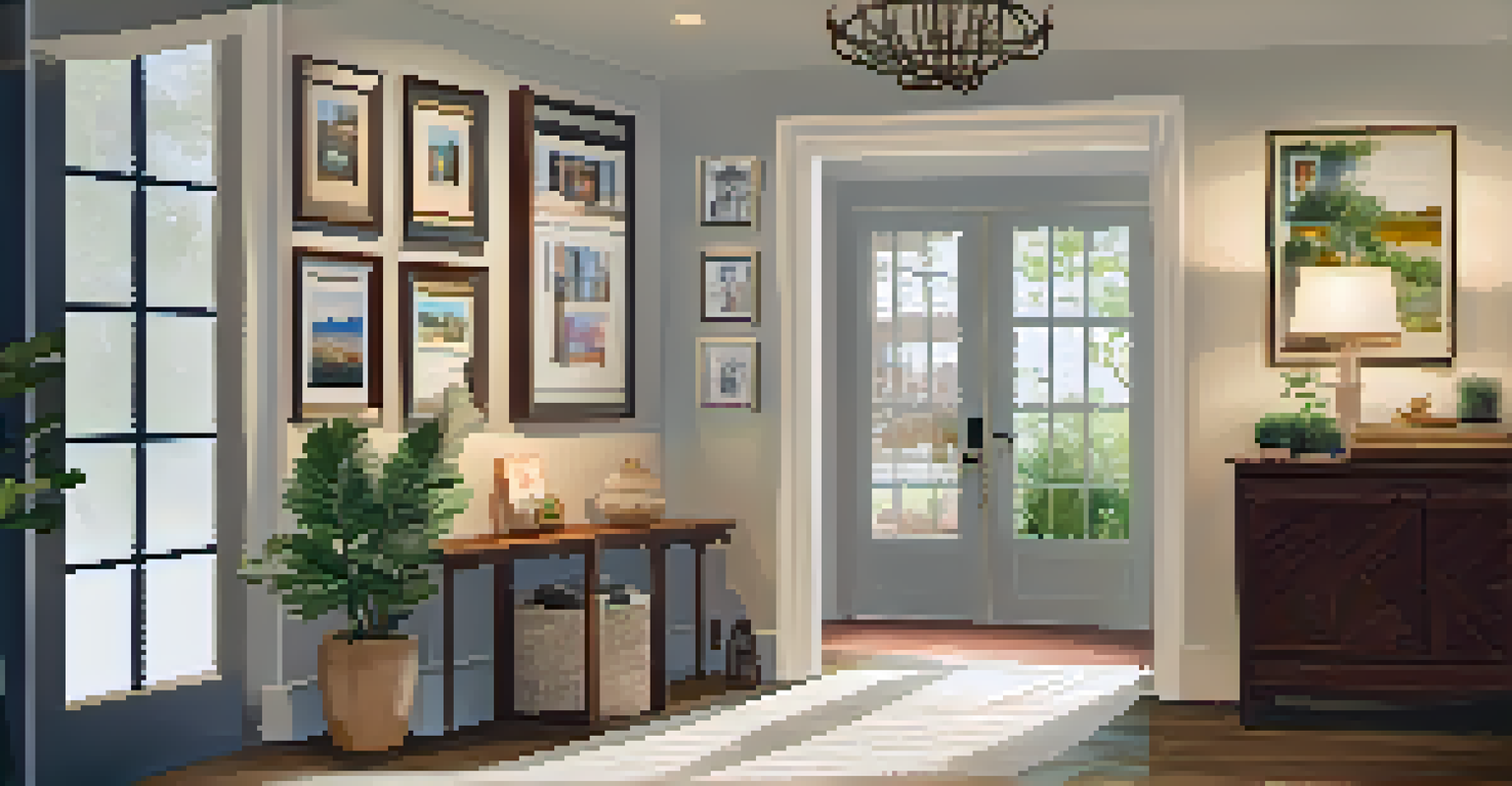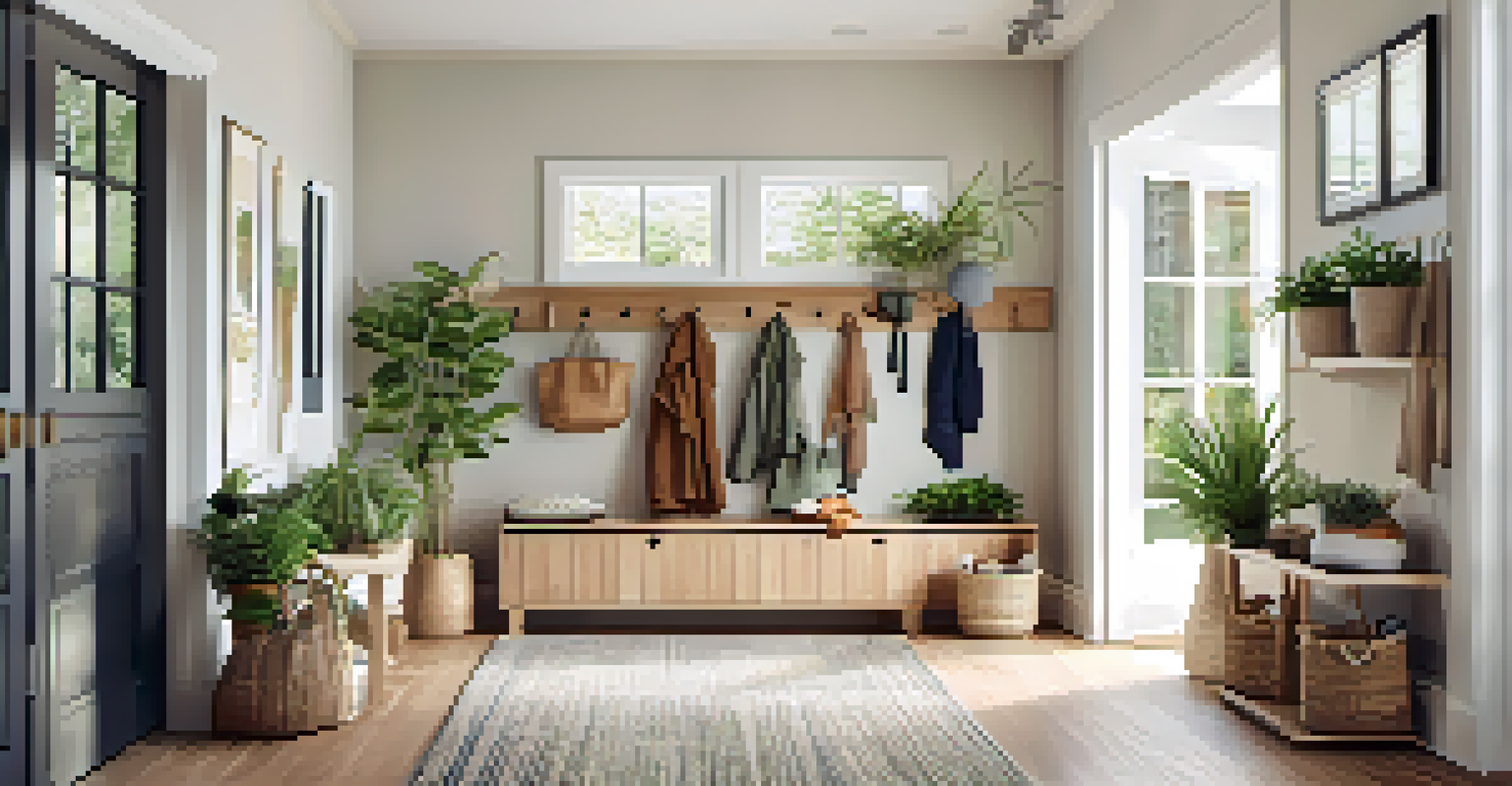Designing Entryways with an Open Floor Plan

Understanding the Role of Entryways in Open Floor Plans
Entryways set the tone for your home, especially in open floor plans. They act as a transition space that welcomes guests and provides a glimpse into your home's style. Without distinct walls to define this area, they can easily blend into living spaces, making design choices crucial.
The entrance of a home is the first impression; it should be a reflection of the owner’s personality.
In open concepts, the entryway serves a dual purpose: it should be functional while also enhancing the aesthetic flow of the space. A well-designed entry can create a sense of organization and comfort as soon as someone steps inside. This is significant because first impressions matter, and a welcoming entry can make anyone feel right at home.
Consider how the entryway interacts with adjoining areas. The use of colors, materials, and furniture should harmonize with the overall design of your home, making the entryway feel like a natural part of the space. Thoughtful design can turn this area into a stylish introduction to your living environment.
Choosing the Right Furniture for Your Entryway
When selecting furniture for an entryway in an open floor plan, functionality is key. Think about pieces like benches, coat racks, and console tables that offer storage while keeping the area tidy. Opting for multifunctional furniture can maximize your space and minimize clutter.

For instance, a stylish bench can serve as a spot to sit while putting on shoes, while also providing storage for bags or seasonal items underneath. A console table can hold keys, mail, or decorative pieces, helping to create an organized and inviting atmosphere. This balance between utility and style is what makes an entryway both practical and beautiful.
Entryways Set the Home's Tone
Entryways serve as a welcoming transition, establishing a sense of style and comfort in open floor plans.
Additionally, ensure that the scale of your furniture complements the surrounding areas. Oversized pieces can overwhelm smaller spaces, while too-small items may get lost in a larger room. Finding the right balance contributes to the overall flow of your home, making it feel cohesive and welcoming.
Incorporating Color and Texture into Entryway Design
Color and texture play vital roles in creating an inviting entryway. A fresh coat of paint or an accent wall can add character and warmth, instantly making the space feel more welcoming. Consider using colors that resonate with your personal style while also harmonizing with the rest of your home.
Your home is living space, not storage space.
Textures, such as a soft rug or decorative wall art, can enhance the sensory experience of entering your home. Rugs can define the entry area, providing both comfort and a visual cue that delineates the space. Similarly, decor elements like mirrors or artwork can reflect light and add depth, making the area feel larger and more inviting.
Experimenting with different materials, such as wood, metal, or fabric, can create a layered look that adds interest. Combining various textures and colors helps establish a unique entryway that feels both personal and connected to the overall design theme of your open floor plan.
Lighting Solutions to Enhance Your Entryway
Proper lighting can transform an entryway, making it feel bright and welcoming. In open floor plans, consider a mix of ambient, task, and accent lighting to create a layered effect. A well-lit entryway not only enhances visibility but also adds to the overall ambiance of your home.
Using pendant lights or chandeliers can serve as focal points that draw the eye upward, making your entryway feel more spacious. Additionally, wall sconces or table lamps can provide softer lighting options for a cozy feel. Natural light should also be maximized, so consider placing mirrors strategically to reflect sunlight and brighten the area.
Functionality in Entryway Furniture
Choosing multifunctional furniture like benches and console tables helps maximize space and maintain organization.
Don't forget about smart lighting options that can adjust according to time of day or mood. Such features can be both functional and stylish, allowing you to create the perfect atmosphere as you welcome guests or come home after a long day.
Adding Personal Touches to Your Entryway
Personal touches can transform a basic entryway into a reflection of your personality. Whether it's family photos, travel souvenirs, or artwork, incorporating these elements can make your entryway feel uniquely yours. It's a chance to showcase your interests and create a warm, inviting space for visitors.
Consider creating a gallery wall or a small display area where these items can shine. This not only adds character to the entryway but also serves as a conversation starter for guests. When they walk in and see something that resonates with them, it can make them feel more connected to your home.
Additionally, seasonal decor can keep the entryway feeling fresh and dynamic. Changing out decorations for holidays or different seasons can maintain a sense of novelty and excitement, making the entryway a continually evolving part of your home.
Utilizing Space Efficiently in Open Entryways
In an open floor plan, space efficiency is crucial for maintaining an organized feel. Use vertical space by incorporating shelves and hooks, which can help keep items off the floor while adding style. This not only maximizes the available area but also keeps the entryway looking tidy.
Consider built-in storage solutions that can seamlessly blend into the design of your home. For example, a built-in bench with storage drawers underneath can provide a stylish seating option while keeping shoes and bags out of sight. This approach minimizes clutter and maintains the open feel of the space.
Personalize Your Entryway Design
Incorporating personal touches and greenery can transform an entryway into a unique and inviting space.
Additionally, think about how you can create zones within your entryway. Designating areas for different purposes—like a shoe drop-off, a mail station, or a place for bags—can help streamline the flow of daily activities. By organizing the space effectively, you create a more functional and enjoyable entryway experience.
Bringing the Outdoors In: Entryway Plants and Greenery
Incorporating plants into your entryway design can bring a breath of fresh air into your home. Greenery not only adds visual interest but also promotes a sense of tranquility. In open floor plans, plants can help define the entryway while connecting it to the outdoors.
Choose plants that thrive in low light if your entryway lacks natural sunlight. Options like snake plants or pothos are resilient and can add a lush feel without requiring too much care. A small potted plant on a console table or a larger floor plant in a corner can create a welcoming ambiance.

Additionally, consider using decorative plant stands or hanging planters to maximize space and add height variations. This layering effect adds depth to the entryway, making it visually appealing while enhancing the overall atmosphere of your home.